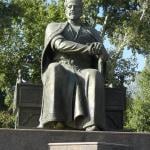
Take one part autobiography, one part historical fiction, one part atlas, one part history of Jesus studies, one part political commentary, one part history of religion, one part “use of the old in the new testament” guide, one part “comparison of Synoptic Gospels,” one part introduction to Biblical archaeology, one part “the Jerusalem equivalent to Fear and Loathing in Las Vegas,” and one part “Who’s Who in historical Jesus scholarship” – and you have Bruce Fisk’s stimulating A Hitchhiker’s Guide to Jesus: Reading the Gospels on the Ground (Baker, 2011). It is a book with really excellent content, and masterfully produced as well.
I will admit, though, that I was a skeptic at first. When the opportunity came to review the book, I was barely interested (mostly because I could not figure out what the book was actually about). However, then I ran into the endorsements: Richard Hays, Gary Burge, Ross Wagner, Marianne Meye Thompson, Mark Allan Powell… OK…clearly Fisk is on to something and I should figure out what it is!
The basic idea is this: a fictionalized character named “Norm” (young student of religion with doubts about his Christian faith) who has the opportunity to go to the Holy Land and work out his thoughts about Jesus right there. The book chronicles, in first person, his adventures and reflections. Fisk admits that his own (many, many) journeys to Jerusalem and its surrounding areas furnish a good amount of information for “Norm’s” itinerary and experiences. In fact, one is often left wondering, did Fisk do that? Did he really run into that person?
A major question that one must ask when reading this book is: what is the purpose of the book? Put another way, at the beginning of this post I used the imagery of ingredients for a recipe. But a recipe for what? What kind of hunger does this meal satisfy?
I think it is meant to introduce students of Jesus (especially those Fisk commonly interacts with in his courses) to a person like them (with some faith and some doubt) who can help them work out their (mis)understanding of Jesus as both real human from Galilee and also his message and what it meant. You can tell that Fisk is not interested in comfortable, quick, or easy answers. The book points towards a sense of owning the complexity in such a way that faith continues to be an adventure. There is no taming Jesus in faith, there is no taming Jerusalem (today, right now), there is no end to the exploring. And…there is a lot of fun to be had on the way (some of it involving narcotics?).
I think what Fisk understands is that most “backgrounds” books are boring. Also, they don’t engage directly in the personal challenges of faith, the questions that are raised by the mystery of who Jesus is and what he was doing in his life on earth. “Norm” illuminates our thinking not simply by answers discovered, but also in the eagerness to explore every nook and cranny of the Holy Land while reading every bit of the Gospels. This is, in a sense, “narrative therapy” for real students who need to “explore” their own doubts when they engage in historical Jesus studies.
And Oh the people you will meet along the way! Fisk has Norm bump into (in all sorts of peculiar situations) a variety of scholars who frequent Jerusalem themselves (unless dead): John Meier, Jonathan Reed, Dom Crossan Scot McKnight, James Dunn, Ben Meyer…Mark Goodacre’s blog (of course) makes an appearance as well.
The brilliant thing about this book is that Fisk is the only one really qualified to write this kind of text, with extensive knowledge of the geography, history, and political climate of Jerusalem, as well as his many years teaching on Jesus. I suppose there are others who might come close to his knowledge, but few who have the creative and engaging writing skills that Fisk demonstrates.
Are there weaknesses in the book? If there would be one that I would flag up, it is this: the uniqueness of the genre and information of the book makes it challenging to use because it doesn’t get very far in any one area of study (history of scholarship, geography, politics, personal doubt, etc…). In that sense, while it would “fit” a “Jesus and the Gospels” class, it would be difficult to assign this as one more book to read alongside an “introduction” (like Stanton or Blomberg). It might work for a hermeneutics course, but you would have the same challenge. That does not disregard its worth, but it does pose challenges for using it as a textbook. So, I am not sure how or why I would use this in a class, but I really do appreciate its creativity and grit.
One last thing – I always like a book that looks good and this is one where the publisher has invested a lot in the quality of the production, with photographs, tons of charts, and lots of sketches here and there. If you get a chance, thumb through the book at SBL or check it out online. Thanks, Bruce, for raising the bar on how Biblical scholars write engaging and illuminating textbooks for our students!
I will have another post on Thursday focusing more specifically on Fisk’s ruminations on the genre of the Gospels. That is what I found most interesting!











